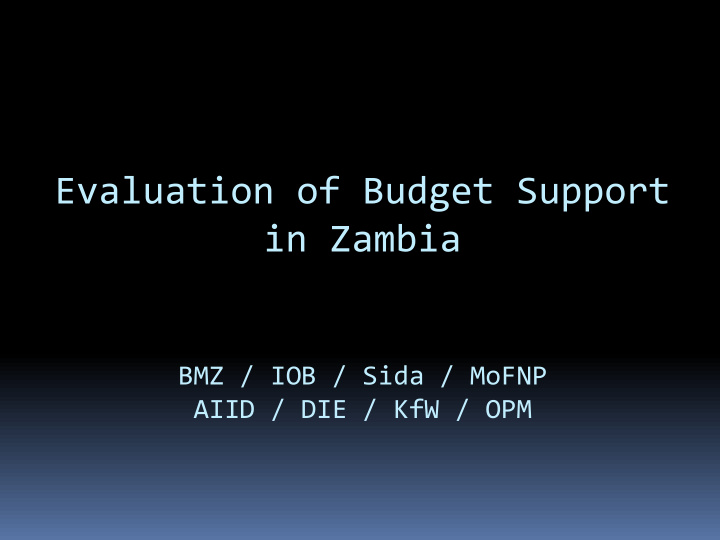



Evaluation of Budget Support in Zambia BMZ / IOB / Sida / MoFNP AIID / DIE / KfW / OPM
Evaluation questions Level 1: BS inputs: money, dialogue and technical assistance Level 2: BS outputs: increased funds, dialogue framework, harmonised approach Level 3: induced outputs Level 4: outcome (descriptive) Level 5: impact measurement (analytical)
Case studies Political economy (step I) Macro economic impact Sector case studies: Agriculture Infrastructure (roads, water) Health Education Poverty impact
Intervention Logic of Budget Support Government Cooperating Partners Government BS Funding Resources Incentives Government Policy Dialogue Strategies Policies & Systems - Policy Content - PFM Conditionality Ownership - Governance transaction costs / Technical Assistance (TA) receptiveness & Capacity Building Commitment Harmonisation among Public Goods Donors and Services Alignment to Government Policies and Systems Impact Sustainable Growth & Poverty Reduction 4
Development of budget support in Zambia 1,400 1,200 1,000 USD Million 800 600 400 200 0 2003 2004 2005 2006 2007 2008 2009 Budget Support ODA DAC Donors (excl BS) ODA non DAC
Some findings Increased expenditure in social sectors Positive development of monetary and fiscal policy Strengthening of PFM and the position of the Auditor General, budget cycle Some improvements in service delivery Slow improvement of poverty indicators
Education (2005-2009) Expenditure : 480 mln – 760 mln Basic education: 288 mln – 400 mln – Teachers: 50,000 – 61,000 Classrooms: 33,000 – 41,000 Pupils: 2.9 mln. – 3.4 mln. Completion rates: 82% – 92% Enrolment poorest quintile: 52% – 73%
Poverty impact Sound monetary and fiscal policies contributed to economic growth Roads sector has not realised its potential Poverty rates go do slowly Rural poverty remains a huge challenge Effectiveness of agricultural subsidies is questioned Impact of population growth Potential Dutch disease effects (lower than assumed)
Challenges GRZ: Slow improvements in key areas Limited ownership Regressive allocations “Vanishing benefits” Cooperating Partners: Unfinished harmonisation agenda Overloaded policy dialogue and PAF Unrealistic expectations
Evaluation challenges Difficult to get the most elementary data (even BS disbursements) No joint knowledge management Poverty data are not very recent Attribution of budget support to macroeconomic developments Congestion of evaluations
Recommend
More recommend